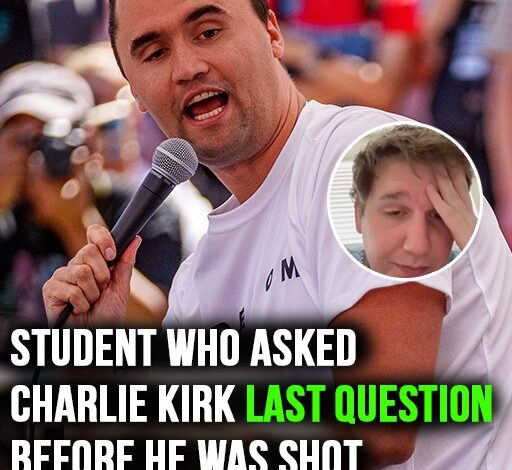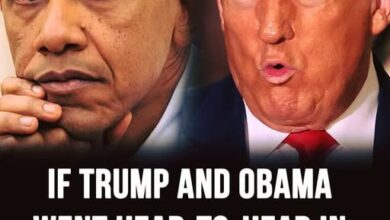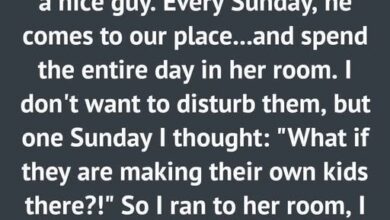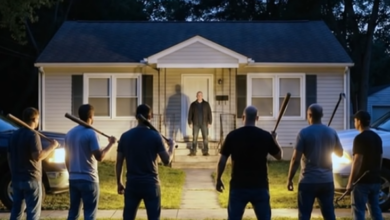
Student who asked Charlie Kirk final question before shooting breaks silence!
The student who asked Charlie Kirk his final question moments before the fatal shooting at Utah Valley University has spoken publicly for the first time, breaking his silence in a raw and emotional video. The incident, which claimed the life of the 31-year-old conservative commentator and co-founder of Turning Point USA, remains one of the most shocking political tragedies in recent memory.
Charlie Kirk had come to Utah as part of his “American Comeback Tour,” a series of events aimed at energizing young conservatives and sparking debate on college campuses. The Sorensen Center auditorium was packed with students, activists, and community members eager to engage with one of the most polarizing voices in American politics. Known for his uncompromising style and willingness to confront critics head-on, Kirk thrived in Q&A sessions that allowed him to clash with opposing viewpoints.
On September 10, 2025, the format unfolded as usual—until it didn’t.
Among the students lining up for questions was 21-year-old Hunter Kozak, a Utah Valley University junior studying sociology. Kozak was no stranger to Kirk’s work. He had posted videos online critiquing Kirk’s statements on transgender issues, particularly comments made after a school shooting where Kirk had speculated about the shooter’s gender identity. Those posts had drawn both support and backlash, leaving Kozak positioned as a recognizable voice in the campus debate about Kirk’s tour stop.
When his turn came, Kozak’s tone was direct but not hostile. He asked Kirk how many mass shooters in the past decade had identified as transgender. Kirk, without hesitation, responded: “Too many.” The crowd applauded, with some nodding in agreement, while others muttered in disapproval. Kozak pressed further, asking about the overall number of mass shootings—a question designed to push Kirk beyond rhetoric and into specifics. Kirk leaned into his answer, pausing briefly as though preparing to expand.
Then, in an instant, the atmosphere shattered.
A sharp crack rang out, at first mistaken by some for a microphone glitch or a prop malfunction. But the truth was far more horrific. Kirk’s body stiffened, his hand instinctively rising to his neck. His microphone slipped from his grasp, clattering against the stage floor as he staggered. Gasps and screams erupted across the auditorium. Witnesses recall the frozen silence that followed before chaos consumed the room—students running for exits, others dropping to the ground, and security rushing to shield those nearest the stage.
The shot had been fired from a rooftop of the Losee Center, roughly two hundred yards from the Sorensen courtyard. Kirk collapsed, bleeding heavily, as his staff screamed for medics. Emergency responders were on the scene within minutes, rushing him into an ambulance. Despite their efforts, Kirk succumbed to his injuries soon after.
The nation learned of his death within hours. By then, the FBI had released footage of a suspect climbing down from the rooftop and fleeing through a parking area. Investigators later discovered a rifle and ammunition wrapped in a blanket in nearby woods, suggesting preparation and intent. As of this writing, the shooter has not yet been apprehended, leaving the public grasping for answers.
For Hunter Kozak, the shock was personal and immediate. In a video posted to Instagram the following day, he struggled to put his emotions into words. Sitting in his dorm room, visibly shaken, Kozak began with a halting admission: “I don’t know how to make this video. I don’t even know what to say. The past 24 hours have been overwhelming, tragic, and impossible to process.”
He recounted the moments leading up to the shooting, acknowledging that his question had become part of the timeline replayed endlessly online. But Kozak was adamant about one point: the act of violence that followed was indefensible. “Whatever disagreements I had with Charlie, whatever criticisms I voiced—none of that justifies what happened. His death is a tragedy, and anyone celebrating it should be ashamed.”
Kozak went further, extending sympathy to Kirk’s wife and children. “I’m a father myself,” he said, his voice catching. “I know what it means to go home to your kids. I can’t imagine what his family is going through right now. They deserve compassion, not cruelty.”
The video quickly spread across social media, drawing both praise and attacks. Some applauded Kozak’s courage for speaking out so soon after the tragedy, while others accused him of inserting himself into a national story. His critics resurfaced his old posts, framing him as part of the environment that targeted Kirk. Supporters countered that his condemnation of violence was genuine and important, especially at a time when the nation risked spiraling into more division.
Meanwhile, the shooting itself has reignited debates about political rhetoric, campus safety, and the toxic nature of modern discourse. Kirk was no stranger to controversy. His confrontational style and unapologetic positions on immigration, gender identity, and free speech made him a lightning rod for criticism. But even many of his fiercest detractors acknowledged that his assassination crossed a line no society can afford to normalize.
Political leaders from across the spectrum issued statements. Former President Donald Trump, a longtime ally of Kirk, said his youngest son Barron had been devastated by the news. Utah Governor Spencer Cox urged calm, declaring, “There is no place for violence in public life.” Democratic leaders, including California Governor Gavin Newsom, joined in condemnation, warning against letting the tragedy deepen partisan hatred.
For students at Utah Valley University, the trauma lingers. Vigils have been held nightly on campus. Handwritten notes, flowers, and candles line the steps of the Sorensen Center. Messages such as “Stay strong, Charlie” and “Truth wins in the end” reflect both grief and defiance, echoing Kirk’s own final words to his wife hours before the attack.
Hunter Kozak, now indelibly linked to that moment, has insisted that his role be seen for what it was: part of a dialogue, not part of a crime. “I asked a question because I believed in challenging him,” he said in his video. “But I never wanted this. None of us did. The violence dishonors everything we claim to stand for.”
As the investigation continues and the manhunt intensifies, Kozak’s statement has added a new layer to the unfolding story. His words remind the public that debates, however sharp, are meant to remain words—not bullets. In a fractured nation, that distinction feels more vital than ever.
The echoes of that night remain haunting: a young man asking a pointed question, a prominent figure answering with characteristic brevity, and then the crack of a rifle cutting through the air. What followed was chaos, mourning, and a nation searching for meaning. And in the middle of it all, a student’s voice—once critical, now grief-stricken—insisting that disagreement must never descend into bloodshed.




